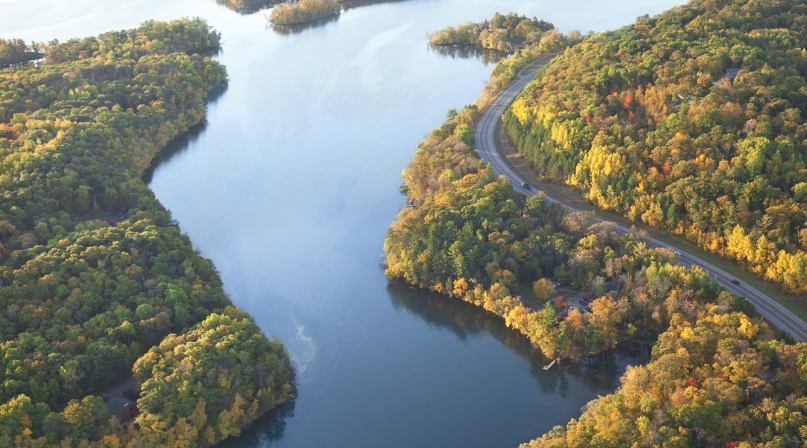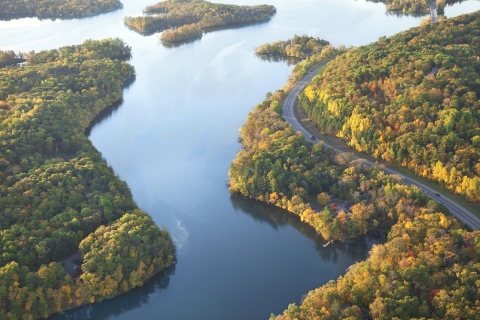EPA and Army Corps WOTUS April 15 Comment Deadline Approaching
Upcoming Events
Related News

Key Takeaways
On February 14, the U.S. Environmental and Protection Agency (EPA) and the U.S. Army Corps of Engineers (Army Corps) officially released the Trump Administration’s proposed new “Waters of United States” (WOTUS) rule defining which bodies of water are subject to federal regulations under the Clean Water Act (CWA). This action represents the second step in the process taken by the EPA and Army Corps to review and replace the Obama Administration’s 2015 WOTUS rule. The proposed rule’s public comment closes next Monday, April 15, 2019.
Counties are encouraged to submit comments to both agencies and provide examples of how the proposed rule would impact county-owned infrastructure, including roads and roadside ditches, drainage and irrigation conveyances, flood control channels, bridge construction and rehabilitation projects and stormwater and wastewater facilities. Additional suggested amendments to the proposed rule are also encouraged.
The agencies will accept written comments on the proposed WOTUS definition until Monday, April 15 through the Federal eRulemaking Portal at www.regulations.gov. Please identify Docket ID No. EPA–HQ–OW–2018– 0149 in your comments.
Click here for sample comments
ABOUT THE PROPOSED RULE
The new proposed definition would create six categories of regulated waters and 11 exemptions. The six categories of WOTUS include: traditional navigable waters; tributaries; certain ditches; certain lakes and ponds; impoundments; and adjacent wetlands. The proposed rule specifies that if water does not meet one of the six listed categories, it will not be considered a WOTUS and clarifies that certain other waters will also no longer be considered a WOTUS, such as ditches that are only wet during rainfall events, groundwater, stormwater control features, wastewater recycling infrastructure built in uplands, converted cropland and waste treatment systems.
Drawing a clear distinction between natural streams and ditches intended for public safety
While the proposed rule attempts to draw a bright line between tributaries and ditches, there remains uncertainty about when a ditch may be jurisdictional. For example, while tributaries are defined as “naturally occurring surface channels” and ditches are defined as an “artificial channel used to convey water,” there are some cases when ditches may be considered jurisdictional under the tributary definition. For example, some roadside and drainage ditches built decades ago in natural stream systems would be jurisdictional if the ditch has year-round or intermittent (seasonal) flow. However, ditches that are only wet during rainfall events would not be jurisdictional under the proposed rule.
Under the proposed rule, the following types of county-owned infrastructure may be jurisdictional:
- Roadside ditches that have flow year-round (perennial flow)
- Roadside and other ditches with intermittent flow (i.e. seasonal) that are a relocated tributary, are excavated in a tributary or touch jurisdictional wetlands
- Roadside and other ditches that have a seasonal flow due to snowmelts and monsoons
- Stormwater systems and wastewater recycling infrastructure located in low-lying wet areas
Counties ask that the agencies establish a categorial exemption for ditches that are intended for public safety.
Status of the current ditch maintenance exemption is uncertain in the pending WOTUS rule
Under law, ditches are regulated under CWA Section 404 for both construction and maintenance activities. While a Section 404(f) exemption exists for ditch maintenance activities, Army Corps districts apply it inconsistently. In some areas, local governments have a blanket exemption, but in other areas, local governments must apply for a special Section 404 permit for ditch maintenance activities. Some counties in hurricane impacted areas have reported difficulty obtaining Section 404(f) exemptions to clean out drainage ditches filled with silt from flooding. These ditches are used to funnel water away from low-lying areas to prevent accidents and flooding of homes and businesses.
Counties ask the agencies to reaffirm in the final rule’s preamble the role that the Section 404(f) ditch maintenance exemption plays. Additionally, we ask the agencies to clarify how and when Section 404(f) exemption can be used and an unequivocal exemption for ditch maintenance activities in the final rule.
The proposed rule’s definition for “intermittent” is cause for concern
In lieu of setting a baseline for what the term intermittent means, the agencies have indicated that the term will be defined at the regional level, which means definitions could vary and be applied differently across the country.
Additionally, it has been noted by county experts in the field that, in some parts of the nation, there is very little difference between the definitions of intermittent (seasonal) and ephemeral (rain-fall events). This may lead to additional confusion.
Counties ask that the agencies clarify how “intermittent” will be defined at the local level. For example, which federal agency would take the lead, how will the geographic region would be determined (i.e. via Army Corps or EPA district, state, watershed, etc.) and how will regional district offices crafting a regional intermittent definition include state and local governments in the process?
Exemptions for stormwater features and wastewater recycling structures constructed in uplands need further clarification
The proposed rule contains a clear exemption for stormwater control features excavated or constructed in upland to convey, treat, infiltrate or store stormwater runoff. It also exempts wastewater recycling structures constructed in uplands, such as detention, retention and infiltration basins and ponds, and groundwater recharge basins.
NACo is generally supportive of these exemptions, with a few exceptions.
There are two outstanding questions within this section. First, while the agencies indicate that the term “upland” is understandable to agency staff and practitioners in the field, it is not well-understood by the everyday person. Since WOTUS is steeped in the Commerce Clause, the term upland becomes especially important for those local governments who built their counties, cities and towns alongside major shipping channels. Usually located alongside rivers, lakes and territorial seas, these communities are generally located in low-lying or coastal areas with high groundwater tables. For these areas, the term “upland” is more uncertain, especially if part of the stormwater system was historically a wetland but has been drained over the years.
Counties request that the agencies clarify the use of the term uplands for stormwater systems, including whether or not the whole system is jurisdictional if the system is only partially constructed in uplands.
Second, the agencies ask for comments on whether the proposed stormwater control features exclusion should be expanded or clarified to include permitted municipal separate storm sewer systems (MS4s). If so, the agencies request comments on whether the exclusion would apply to the entire MS4 or limited portions of the system. These questions are directly relevant to any local government who uses a natural stream as part of their MS4, which is permitted under the CWA Section 402 National Pollutant Discharge Elimination System (NPDES) permit program.
The Section 402 permit program contains limits on what can be discharged into the stormwater system, includes monitoring and reporting requirements and provides parameters for how water can be treated and cleaned before it is released into a jurisdictional WOTUS, which is regulated under the CWA Section 404 for construction and maintenance activities. The important distinction between Section 402 and 404 is that polluted water cannot be legally “treated” in a WOTUS. If a stream within a MS4 is designated as a WOTUS, that would automatically set up a conflict between the CWA Section 402 and 404 permit programs and could open a legal quagmire for both the CWA and local governments.
Effectively craft a nationwide WOTUS map
Within the proposed rule, the agencies are asking for comments as to how they could establish an approach to authorize states, tribes and federal agencies to establish geospatial datasets of WOTUS, as well as waters that the agencies propose to exclude in the rule.
While the question focuses primarily on other levels of government, counties collect a variety of Geographic Information System (GIS) related data which we use internally and often share with states. This data is used for comprehensive planning, transportation, growth development, redistricting and other uses.
NACo recommends that counties explain how and why we collect data and how it may be used to create a nationwide WOTUS map.
WOTUS BACKGROUND INFORMATION
“Waters of the U.S.” (WOTUS) is a term used in the Clean Water Act to determine what waters and their conveyances fall under federal and state permitting authority. In 2014, EPA and the Army Corps undertook an effort to rewrite and expand the current WOTUS definition. In 2015, the Obama Administration finalized a new definition of WOTUS, which was immediately challenged in the courts. NACo has expressed multiple concerns on the 2015 WOTUS rule's impact on county-owned and maintained roadside ditches, bridges, flood control channels, drainage conveyances and wastewater and stormwater systems and has called for the final rule to be withdrawn until further analysis and more in-depth consultation with state and local officials be completed.
Currently, the 2015 WOTUS rule is currently in effect in 22 states (California, Connecticut, Delaware, Hawaii, Illinois, Maine, Maryland, Massachusetts, Michigan, Minnesota, New Hampshire, New Jersey, New York, Ohio, Oklahoma, Oregon, Pennsylvania, Rhode Island, Tennessee, Vermont, Virginia and Washington), while regulations from 1986 are in effect in the other 28 states. As a result, in February 2017, President Trump released Executive Order (EO) 13778: Restoring the Rule of Law, Federalism, and Economic Growth by Reviewing the “Waters of the U.S.” Rule, which instructed the EPA and the Corps to review and rewrite the 2015 WOTUS rule.
ADDITIONAL NACo RESOURCES
NACo’s Comparison Chart Between the 1986 and 2015 WOTUS Rules and the 2019 Proposed Rule

Attachments
Related News

U.S. House of Representatives passes SPEED Act and other permitting reform bills
On December 18, the U.S. House of Representatives passed the SPEED Act (H.R. 4776). The SPEED Act would strengthen county involvement in decision-making and make needed commonsense reforms to the federal environmental review process.

House Natural Resources Committee advances the Endangered Species Act Amendments Act of 2025
On December 17, the House Natural Resources Committee advanced the Endangered Species Act (ESA) Amendments Act of 2025 (H.R. 1897). The version passed by the committee adopted several changes from the initial bill and would address key county concerns by improving the implementation of the ESA. The legislation now awaits a floor vote before the whole U.S. House of Representatives.

Senators introduce bipartisan UPGRADE Act to support small and rural public water systems
On December 15, Sens. Lisa Blunt Rochester (D-Del.) and Roger Wicker (R-Miss.) introduced the Unincorporated Partnerships for Grant Resources, Assistance, and Drinking Water Enhancements (UPGRADE) Act (S. 3465), a bipartisan bill that would strengthen federal support for small public water systems and helps unincorporated communities access clean and affordable water.